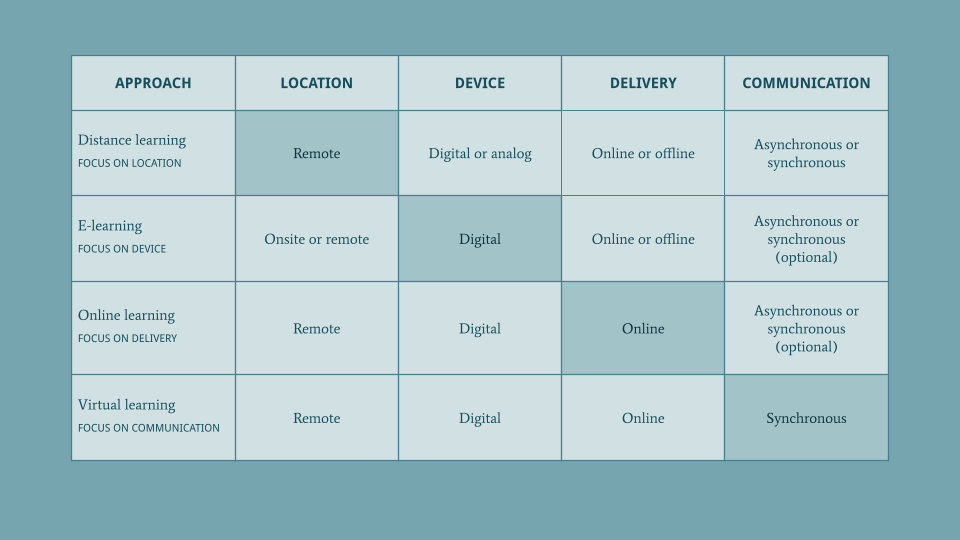Many people use the terms “distance learning”, “e-learning”, “online learning”, and “virtual learning” interchangeably. E-learning, online learning, and virtual learning all fall into the umbrella concept of technology-enhanced learning. However, they mean different things, and all focus on a different aspect of education. In order to distinguish them, it’s useful to think about where and how the learning process happens.
The location can be onsite or remote, the communication can be synchronous or asynchronous, the delivery can be online or offline, and the device can be digital or analogue. Here is an overview of how distance learning, e-learning, online learning, and virtual learning differ in terms of location, communication, delivery mode, and device:
Distance learning
Let’s start with the simplest concept: distance learning simply means that educators and students are in a different location. It doesn’t mean the instruction is necessarily delivered online. Distance learning has existed for a long time — way before the advent of the Internet! In 1728, the Boston Gazette published an advert for “Caleb Philipps, Teacher of the new method of Short Hand”, seeking students who wanted to sign up to receive weekly mailed lessons. In 1858, The University of London was the first university to start offering distance learning degrees.
E-learning
E-learning means electronic learning. An interactive learning application on a tablet not connected to the Internet would be considered an e-learning application, even though it is not online. In fact, in e-learning, communication is entirely optional. An in-app curriculum could be crafted in advance, with content being “dripped” whenever a learner progresses to the next module, without the need for an educator to interact with the students. E-learning also doesn’t need to be remote. That same e-learning application we just described could be used onsite by students in a classroom with the help of their teacher. Again, e-learning simply focuses on the digital aspect of education.
Online learning
This one is pretty self-explanatory: online learning is about learning over the Internet. However, perhaps counterintuitively, communication is optional in online learning as well. Video lectures could be recorded and uploaded in advance, without the option for students to connect together or ask questions to an educator. Of course, that probably would not be the optimal instructional design, but it would still be considered online learning, as the learning experience is delivered over the Internet. A wider definition of online learning would even include any self-directed studies conducted online, such as looking up information on search engines, watching educational videos, or reading blog posts about a study topic.
Virtual learning
The most recent cousin of these technology-enhanced learning approaches is virtual learning, which was propelled to the forefront of education during the pandemic. In a virtual classroom, the teacher and the students join the class at the same time, which helps facilitate real-time interactions. Similarly to a brick-and-mortar classroom, virtual classrooms offer a synchronous experience: they allow students to ask questions and interact with their teachers and their peers. The same way a traditional classroom is usually part of a school, a virtual classroom is often part of a wider virtual learning environment, which can include additional resources, such as study material, schedules, assessments, and ways to reach out to members of the school staff outside of class.
These are the four most common technology-enhanced learning approaches used today in education. Often, they are not used in isolation: for instance, blended learning is popular, with a mix of onsite lectures and online activities.
As technology evolves, these definitions are also bound to change. In a similar way to how mobile learning offers a more flexible learning experience, virtual reality and augmented reality both promise a more immersive learning experience. Brain-computer interfaces are also being explored as potential learning devices, and some think decentralised learning may radically alter the way we think about education.
Whatever the next steps in technology-enhanced learning, now you will know the difference between distance learning, e-learning, online learning, and virtual learning!

